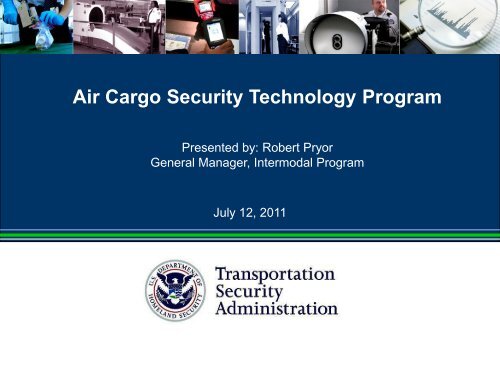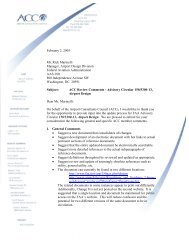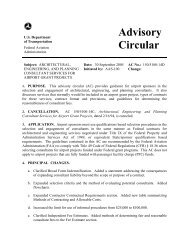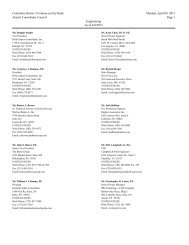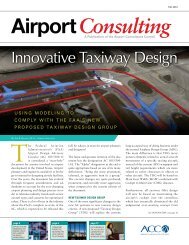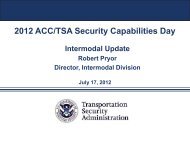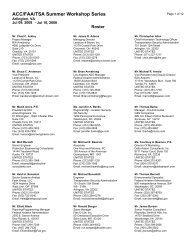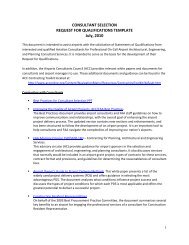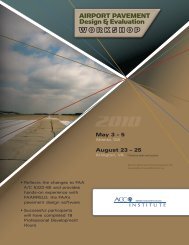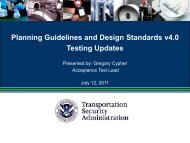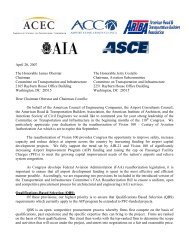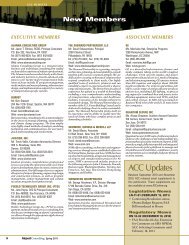Air Cargo Technology Program and Intermodal ... - ACConline.org
Air Cargo Technology Program and Intermodal ... - ACConline.org
Air Cargo Technology Program and Intermodal ... - ACConline.org
You also want an ePaper? Increase the reach of your titles
YUMPU automatically turns print PDFs into web optimized ePapers that Google loves.
<strong>Air</strong> <strong>Cargo</strong> Security <strong>Technology</strong> <strong>Program</strong><br />
Presented by: Robert Pryor<br />
General Manager, <strong>Intermodal</strong> <strong>Program</strong><br />
July 12, 2011
Agenda<br />
• <strong>Air</strong> <strong>Cargo</strong> Security <strong>Technology</strong> <strong>Program</strong> (ACSTP) Overview<br />
• ACSTP Key Initiatives<br />
• ACSQT Submission <strong>and</strong> Test Processes<br />
• <strong>Air</strong> <strong>Cargo</strong> Screening <strong>Technology</strong> List<br />
• ACSTL Status (as of Version 6.6)<br />
• Upcoming Qualification Activities<br />
Slide 2
ACSTP Mission & Vision<br />
Mission:<br />
ACSTP evaluates <strong>and</strong> qualifies air cargo screening technologies to prevent explosive devices <strong>and</strong> other<br />
dangerous goods from being transported in air cargo on passenger aircraft. Additionally, ACSTP aims to<br />
evaluate <strong>and</strong> qualify human detection technologies to prevent human intruders from invading cargo<br />
aircraft <strong>and</strong> using them as weapons of mass destruction.<br />
Vision:<br />
ACSTP strives to assess <strong>and</strong> test cargo screening technologies that are critical to the success of the<br />
Certified <strong>Cargo</strong> Screening <strong>Program</strong> (CCSP), the 100% Screening M<strong>and</strong>ate, <strong>and</strong> air cargo security at<br />
large. These technologies include cargo screening equipment, chain of custody technologies, <strong>and</strong> the<br />
management of a pipeline for future, more efficient <strong>and</strong> effective cargo security screening technologies.<br />
Strategic Objectives:<br />
Near Term<br />
Medium Term<br />
Long Term<br />
Qualify viable air cargo screening technology that is currently in the marketplace <strong>and</strong>/or<br />
can be quickly modified to meet the requirements of the 100% cargo screening m<strong>and</strong>ate.<br />
Evaluate emerging air cargo screening technologies <strong>and</strong> provide feedback to vendors to<br />
enhance products for qualification <strong>and</strong> the development of refined technology st<strong>and</strong>ards.<br />
Collaborate through the DHS Capstone IPT with S&T to identify current technology<br />
gaps/opportunities <strong>and</strong> support R&D efforts for future sophisticated air cargo screening<br />
technology requirements.<br />
Slide 3
ACSTP Key Initiatives Summary<br />
<strong>Air</strong> <strong>Cargo</strong> Screening<br />
Qualification Test<br />
(ACSQT)<br />
Innovative<br />
<strong>Technology</strong> Review<br />
Process<br />
(ITRP)<br />
Supply Chain<br />
Integrity <strong>Program</strong><br />
(SCIT)<br />
Data Analysis<br />
Reduction Team<br />
(DART)<br />
Description<br />
• The ACSQT process involves the demonstration, verification,<br />
<strong>and</strong> validation that a c<strong>and</strong>idate cargo screening technology<br />
meets established TSA requirements <strong>and</strong> st<strong>and</strong>ards.<br />
• ITRP is a process for ACSTP to assess <strong>and</strong> evaluate<br />
innovative <strong>and</strong> emerging technologies that are still<br />
developing but not yet commercially available.<br />
• ACSTP evaluates <strong>and</strong> develops st<strong>and</strong>ards for supply chain<br />
integrity technologies for certified cargo screening facilities to<br />
use when securing screened cargo from point of screening<br />
until loading aboard aircraft. Examples include tapes, ties,<br />
mechanical locks, <strong>and</strong> secure cartons.<br />
• DART processes <strong>and</strong> analyzes operational <strong>and</strong> technical<br />
data from regulated industry to streamline <strong>and</strong> integrate air<br />
cargo policy, procedures <strong>and</strong> regulations.<br />
FY11 Activities<br />
• Completed laboratory testing for QG3<br />
(EMD) Submission Window 1<br />
• Published approved configuration<br />
updates for all technology devices on<br />
the TSA <strong>Air</strong> <strong>Cargo</strong> Screening<br />
<strong>Technology</strong> List (ACSTL)<br />
• Published ACSQT Broad Agency<br />
Announcement (BAA) Version 2.0 on<br />
fbo.gov to open new submission<br />
windows<br />
• Coordinated with DHS S&T for R&D of<br />
acoustic technology <strong>and</strong> palletized<br />
cargo screening systems<br />
• Continued evaluation of tamper<br />
evident tape products for possible<br />
qualification <strong>and</strong> application to cargo<br />
supply chain operations<br />
• Completed air cargo operational <strong>and</strong><br />
business l<strong>and</strong>scape study<br />
Slide 4
Submission Process<br />
Test Process<br />
ACSQT Submission <strong>and</strong> Test Processes<br />
ACSTP Releases Broad Agency<br />
Announcement (BAA)<br />
ACSTP Convenes Technical<br />
Review Panel (TRP)<br />
Vendors Submit QDPs<br />
Vendors submit white papers with basic<br />
system <strong>and</strong> compliance information.<br />
Vendors that pass the white paper review<br />
are required to submit a Qualification<br />
Data Packet (QDP) to substantiate<br />
conformance to the Performance<br />
Specification (PS).<br />
The TRP reviews the QDP for<br />
compliance. Vendors whose QDPs are<br />
evaluated favorably may enter the<br />
qualification test process.<br />
Slide 5
<strong>Air</strong> <strong>Cargo</strong> Screening <strong>Technology</strong> List<br />
The ACSTL indicates the equipment that can be used by air carriers, indirect air carriers, independent cargo<br />
screening facilities, <strong>and</strong> shippers to screen for domestic <strong>and</strong> outbound air cargo.<br />
• The ACSTL includes three sections:<br />
• Qualified<br />
• Equipment that has passed formal TSA sponsored laboratory, commodity<br />
<strong>and</strong> operational testing, <strong>and</strong> is deemed qualified for screening operations.<br />
When procuring equipment, regulated parties should select equipment from<br />
the Qualified technology section.<br />
• Approved<br />
• Equipment that has passed laboratory <strong>and</strong> commodity testing <strong>and</strong> has<br />
been conditionally approved for screening operations. This equipment is<br />
currently undergoing or scheduled for operational field test activities.<br />
• Gr<strong>and</strong>fathered<br />
• Equipment that is currently approved to screen cargo but has a stated<br />
expiration date. This allows regulated parties who are using the<br />
gr<strong>and</strong>fathered technology an opportunity to gradually phase out the<br />
equipment <strong>and</strong> transition to devices listed in the qualified or approved<br />
sections. Regulated parties should reference the qualified or approved<br />
sections for their procurement needs.<br />
• TSA publishes new versions of the ACSTL as new technologies become<br />
qualified through the ACSQT.<br />
• A Non-SSI version of the ACSTL is available on tsa.gov, under <strong>Air</strong><br />
<strong>Cargo</strong>’s St<strong>and</strong>ards <strong>and</strong> Regulations.<br />
Slide 6
ACSTL Status (as of Version 6.6)<br />
X-Ray<br />
• Qualified: 60 X-Ray devices from 7 OEMS<br />
• 20 Capacity A systems<br />
• 27 Capacity B systems<br />
• 13 Capacity C systems<br />
Explosives<br />
Trace<br />
Detection<br />
• Qualified: 2 ETD devices from 2 OEMs<br />
• Waived: 6 ETD devices from 2 OEMs<br />
Electronic<br />
Metal<br />
Detection<br />
• Approved: 3 EMD devices from 2 OEMs<br />
• Under Evaluation: 8 EMD devices from 4 OEMs<br />
Explosives<br />
Detection<br />
Systems<br />
• Qualified: 8 EDS devices from 3 OEMs<br />
Slide 7<br />
Slide 7<br />
Slide 7
Upcoming Qualification Activities<br />
The ACSQT BAA Version 2.0 includes details for upcoming submission windows for QG1 (X-Ray),<br />
QG2 (ETD), <strong>and</strong> QG3 (EMD), available through fbo.gov.<br />
Qualification<br />
Group<br />
Submission Window<br />
White Paper Submission Deadline<br />
QG1<br />
QG2<br />
QG3<br />
SW3 07/01/2011<br />
SW4 08/28/2012<br />
SW2 05/27/2011<br />
SW3 08/21/2012<br />
SW2 08/01/2011<br />
SW3 09/19/2012<br />
Slide 8
<strong>Intermodal</strong> Transportation Protection <strong>Program</strong><br />
Presented by: Robert Pryor<br />
General Manager, <strong>Intermodal</strong> <strong>Program</strong><br />
July 12, 2011
Agenda<br />
• <strong>Intermodal</strong> Background<br />
• <strong>Intermodal</strong> <strong>Technology</strong> Pilot History<br />
• Mission <strong>and</strong> Goals<br />
• Input to Research <strong>and</strong> Development<br />
• Analysis of <strong>Technology</strong> Integration<br />
• Product Lists <strong>and</strong> Databases<br />
• Path Forward<br />
Slide 10
<strong>Intermodal</strong> Background<br />
Assessments<br />
of Existing<br />
Technologies<br />
• Particularly since fiscal year 2003/2004, in response to the Madrid attacks <strong>and</strong> increasing threats<br />
to passenger ferries, TSA has collaborated in field experiments <strong>and</strong> pilot test projects assessing<br />
innovative uses of existing technologies in mass transit venues <strong>and</strong> other surface transportation<br />
modes.<br />
Results of<br />
Past<br />
Assessments<br />
• Results of these efforts showed that airport checkpoint-style technologies had only limited<br />
applicability to such environments, <strong>and</strong> that different security technologies <strong>and</strong> operational<br />
approaches were needed in mass transit <strong>and</strong> rail <strong>and</strong> surface venues.<br />
Current State<br />
• There is ample evidence of multiple threat vectors in mass transit environments <strong>and</strong> the continuing<br />
desire by terrorists to attack mass transit targets.<br />
Slide 11
<strong>Intermodal</strong> <strong>Technology</strong> Pilot History<br />
The following examples reflect 8 of the 21 major pilots from 2004-2010<br />
Presidential Inauguration<br />
Mass Transit<br />
• Smiths SABRE 4000<br />
H<strong>and</strong>held ETD<br />
• GE Itemizer 3 Table Top ETD<br />
St<strong>and</strong>off Detection of Mass Transit PBIED<br />
Mass Transit<br />
• QinetiQ SPO 20 <strong>and</strong> SPO 07<br />
remote threat imaging systems<br />
Pre-Boarding Vehicle Inspection Phase II<br />
Maritime<br />
• CarSCAN Portal<br />
• Under Vehicle Screening<br />
System<br />
FY 2004 FY 2005 FY 2006 FY 2007 FY 2008 FY 2009 FY 2010 FY 2011<br />
SAIL I<br />
Maritime<br />
•Explosives Trace Detection<br />
TRIP I<br />
Mass Transit<br />
• Smiths 400B Table Top<br />
Trace<br />
• L3 MVT Checked Bag Automated<br />
Explosives Detection System<br />
• GE Explosives Trace Portal<br />
Legend<br />
Pilot<br />
Modality<br />
<strong>Technology</strong><br />
Vehicle Comm<strong>and</strong> <strong>and</strong> Control Phase I<br />
Mass Transit<br />
• Qualcomm Vehicle Location <strong>and</strong> remote<br />
Engine Control Systems (Satellite)<br />
• MAGTEX Remote Engine Control Systems<br />
(Cellular Network)<br />
SAIL III<br />
Maritime<br />
• QinetiQ SPO 20 <strong>and</strong> SPO 07 Remote MMQ<br />
Threat Imaging Systems<br />
• AS&E GEMINI Combined Transmission X<br />
Ray <strong>and</strong> Backscatter Screening System<br />
Slide 12<br />
Pre-Operation Inspection of Mass Transit<br />
Rail Cars<br />
Mass Transit/Rail<br />
• Under Vehicle Screening<br />
System
Mission <strong>and</strong> Goals<br />
Mission:<br />
Enhance intermodal transportation security by developing requirements for, <strong>and</strong> evaluating, security<br />
technologies that: protect employees <strong>and</strong> travelers, eliminate vulnerabilities, mitigate damages, identify<br />
potential threats, provide decision support, <strong>and</strong> facilitate recovery from intentional assault on<br />
commercial intermodal transportation modes <strong>and</strong> related infrastructure.<br />
Goals:<br />
Near Term<br />
• Align <strong>Intermodal</strong> Transportation Protection <strong>Program</strong> with the TSA Transportation Sector<br />
Network Management (TSNM) <strong>org</strong>anization<br />
• Provide technology <strong>and</strong> technical services to prevent <strong>and</strong> deter acts of terrorism using, or<br />
against, mass transit <strong>and</strong> rail systems<br />
• Create an integrated test bed for technologies to support pilots <strong>and</strong> field experiments in mass<br />
transit environments<br />
Medium Term • Enhance resilience of intermodal transportation systems<br />
Long Term • Improve the cost effective use of resources for intermodal transportation security<br />
Slide 13
Input to Research <strong>and</strong> Development<br />
<strong>Intermodal</strong>:<br />
• Coordinates requirements for research <strong>and</strong> development investment in emerging technologies<br />
• Leverages private industry developments in suitable technologies<br />
• Recommends <strong>and</strong> evaluates modifications to existing or emerging technologies to meet client<br />
needs<br />
Requirements Timeline<br />
Requirements for inclusion in the <strong>Intermodal</strong> Transportation Protection <strong>Program</strong> are solicited<br />
annually in 2nd Quarter, in concert with other requirements calls such as S&T’s Capability Gap<br />
submission window.<br />
Requirements fitting within<br />
TSA’s responsibilities<br />
under TSA/S&T MOA are<br />
evaluated <strong>and</strong> prioritized<br />
Requirements for longer<br />
term R&D are forwarded to<br />
S&T (e.g. Explosives,<br />
Infrastructure, Chem Bio,<br />
Rad Nuc)<br />
<strong>Intermodal</strong> spend plan is<br />
established in the 3 rd<br />
Quarter based on priorities<br />
<strong>and</strong> available funding, <strong>and</strong><br />
as coordinated with<br />
<strong>Intermodal</strong> GMs<br />
Slide 14
Analysis of <strong>Technology</strong> Integration<br />
<strong>Intermodal</strong>:<br />
• Collaborates with appropriate agencies <strong>and</strong> stakeholders to determine best practices,<br />
most useful technological employment, <strong>and</strong> concepts of operation (CONOPS)<br />
• Incorporates lessons learned from field experiments <strong>and</strong> pilots<br />
• Plans, coordinates, <strong>and</strong> supports technology-related experiments <strong>and</strong> exercises<br />
• Supports assessments of safety, security, <strong>and</strong> reliability of technology<br />
implementations, including technology <strong>and</strong> analytic support for development of<br />
technology-related Corporate Security Reviews design<br />
Slide 15
Product Lists <strong>and</strong> Databases<br />
After baseline capabilities analysis, market surveys, technical evaluations, field experiments, <strong>and</strong><br />
pilots, <strong>Intermodal</strong> then:<br />
Determines viability of<br />
production base<br />
Evaluates vendors’<br />
economic <strong>and</strong> business<br />
viability<br />
Provides final<br />
acceptance of<br />
effectiveness <strong>and</strong><br />
suitability<br />
Establishes product lists<br />
<strong>and</strong> databases, including<br />
recommendations for<br />
grants guidance <strong>and</strong> lists<br />
Product List Examples<br />
Authorized Equipment List - maintained by FEMA<br />
The TSA Qualified <strong>Technology</strong> List - maintained by TSA OST<br />
Slide 16
Path Forward<br />
Current St<strong>and</strong>ards Approach:<br />
• To meet requirements of Executive Order 13146, <strong>and</strong> many requests from intermodal<br />
transportation agencies, TSA has established an ongoing program to develop, coordinate, <strong>and</strong><br />
publish performance based specifications for explosives detection equipment.<br />
Specifications are:<br />
• Developed by TSA <strong>and</strong> other federal agencies desiring to participate, in collaboration<br />
with interested parties <strong>and</strong> stakeholders<br />
• Under Federal government content <strong>and</strong> configuration management control throughout<br />
their life<br />
• Available free of charge to any transportation authority, regardless of membership or<br />
affiliation or lack thereof<br />
• Available to vendors, consistent with limitations of restricted content such as SSI or<br />
classified information<br />
• Useful in defining products eligible for grant funding<br />
Slide 17
Path Forward (cont.)<br />
Qualification Strategy:<br />
• Strong movement in Executive Branch <strong>and</strong> Congress to require product qualification testing to<br />
become fee for service.<br />
• TSA proposes to collaborate with DHS in establishing a list of qualified laboratories for assessment<br />
of products against st<strong>and</strong>ards, at vendor expense.<br />
Benefits:<br />
• Places product maturity risk on vendor vice the government<br />
• Avoids anti-competitive provisions of Federal Acquisition Regulation<br />
• Equal opportunity for all vendors<br />
• Allows assessment of products against SSI or classified requirements, without vendor<br />
necessarily being in the National Industrial Security <strong>Program</strong><br />
• May facilitate Safety Act reviews<br />
• Transportation authorities could require proof of qualification before procurement; will<br />
weed out ineffective or unsuitable products<br />
Slide 18
QUESTIONS<br />
Slide 19


